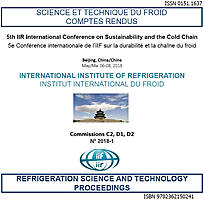
IIR document
A study of improving energy efficiency of small supermarkets by modelling interactions between building, HVAC, refrigeration and display product.
Number: pap. 4
Author(s) : MYLONA Z., KOLOKOTRONI M., TASSOU S. A.
Summary
There is evidence that food retail has shifted towards smaller stores and food products requiring less time for cooking. Small supermarkets (<400m2) usually located within urban areas have higher energy intensity than larger supermarkets because of the high ratio of food against non-food products. An energy and thermal small supermarket model was developed based on EnergyPlus using a coupling approach on the interdependence of subsystems andverifiedwith operational data. Simulations ofenergy efficient retrofits indicate savings of up to 17% with integrated improvements of building design, lighting, refrigeration and HVAC systems. Analysis of refrigeration type and food ratios indicates reduction of total and refrigeration energy consumption with decreasing frozen foods, but increase for the HVAC system making its choice more critical. Location within the urban heat island also has a small impact on the total energy use more pronounced for the HVAC and depending on the refrigeration system.
Available documents
Format PDF
Pages: 9
Available
Public price
20 €
Member price*
Free
* Best rate depending on membership category (see the detailed benefits of individual and corporate memberships).
Details
- Original title: A study of improving energy efficiency of small supermarkets by modelling interactions between building, HVAC, refrigeration and display product.
- Record ID : 30023345
- Languages: English
- Source: 5th IIR International Conference on Sustainability and the Cold Chain. Proceedings: Beijing, Chine, 6-8 avril 2018
- Publication date: 2018/04/06
- DOI: http://dx.doi.org/10.18462/iir.iccc.2018.0004
Links
See other articles from the proceedings (72)
See the conference proceedings
Indexing
-
Carbon reduction opportunities for supermarkets.
- Author(s) : EVANS J. A., MAIDMENT G. G., BROWN T., et al.
- Date : 2016/04/07
- Languages : English
- Source: 4th IIR International Conference on Sustainability and the Cold Chain. Proceedings: Auckland, New Zealand, April 7-9, 2016.
- Formats : PDF
View record
-
Market introduction of commercially viable CO2 ...
- Author(s) : FINCKH O., SIENEL T.
- Date : 2010/04/12
- Languages : English
- Source: 9th IIR-Gustav Lorentzen Conference on Natural Working Fluids (GL2010). Proceedings. Sydney, Australia, April 12-14, 2010.
- Formats : PDF
View record
-
Theoretical evaluation of integrated systems fo...
- Author(s) : CECCHINATO L., CORRADI M., FORNASIERI E., et al.
- Date : 2010/03/29
- Languages : English
- Source: 1st IIR International Conference on Sustainability and the Cold Chain
- Formats : PDF
View record
-
Taking a sensible choice of sustainable superma...
- Author(s) : ISLAM R.
- Date : 2012/07/16
- Languages : English
- Source: 2012 Purdue Conferences. 14th International Refrigeration and Air-Conditioning Conference at Purdue.
- Formats : PDF
View record
-
Modelling energy consumption in supermarkets to...
- Author(s) : EID E., FOSTER A., EVANS J., LEDUCQ D., NDOYE F. T., ALVAREZ G.
- Date : 2023/08/21
- Languages : English
- Source: Proceedings of the 26th IIR International Congress of Refrigeration: Paris , France, August 21-25, 2023.
- Formats : PDF
View record
